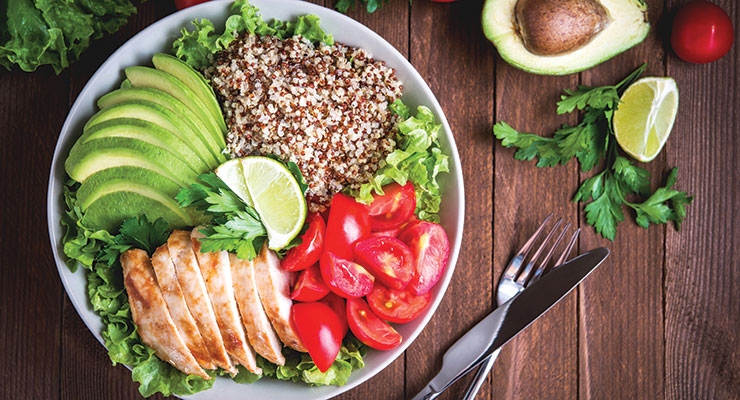Features
Key Trends in Functional Foods & Beverages for 2019
From personalized nutrition plans to naturally healthy foods, consumers will pay a premium for products.

By: Julian Mellentin

As brand owners, from Unilever and Danone down to the smallest and most entrepreneurial of startups, have found to their cost, no matter how smart your company is we are all at the mercy of trends. Our power to influence them is limited. Success comes from keeping an eye on the approaching waves, and if they’re right for your brand, catching them at the right time and successfully surfing them.
Personalization & Fragmentation
For consumers and businesses alike, this is a time of confusion and opportunity, as old health rules are overturned, new ideas emerge, old ingredients are reborn, and retail channels shift.
Consumer beliefs about what “healthy” means are fragmenting, and personalization is already an established part of consumer behavior, creating a wealth of opportunities. Drivers of the fragmentation of markets and consumers’ increasingly personalized choices include:
1. Loss of confidence in experts: People no longer see dietitians and health professionals as the experts on food and health. It isn’t surprising that consumers think dietary advice often flips 180 degrees.
For example, eggs today are promoted for their protein and other nutrients, but 20 years ago they were demonized by dietitians for their cholesterol content. Butter was demonized for 50 years, but now we know that in moderation it poses no risk to cardiovascular health, and it’s “more natural” and less processed than the margarines people were told to eat in its place.
The discovery that these and many other natural foods not only do no harm but also make a positive contribution to health has pushed many people to become their own experts.
Unsurprisingly, 76% of Americans think the messages about food and health are confusing, according to the International Food Information Council (IFIC) Food and Health Survey.
2. People are empowered by technology: A host of websites, apps, and social media platforms enable consumers to do their own research about food and health; with this steadily increasing knowledge, people feel more confident to create personalized healthy eating patterns and dietary choices.
For 50% of the population, New Nutrition Business consumer research has found, the idea that each of us is unique and therefore has unique nutritional and metabolic needs is becoming an accepted fact.
We are all food explorers now. Every age group—with millennials out in front—is engaged in an endless, restless search for something new and different. Consumers are willing to try almost anything new; they are eager for provenance, clean label, and new/interesting tastes and experiences.
The scientific community may have a low opinion of the standard of current DNA tests, but consumers are embracing them, with 19% of Americans saying they have taken a DNA test for dietary reasons.
Makers of dietary supplements are likely to benefit first. Supplements are much easier to reformulate or individually adapt than foods and beverages. More supplement companies are offering personalized nutrition solutions, such as VITL and Vitamin Manager. These companies are connecting with consumers who want individual solutions in a quick, non-intrusive and easy way.
For food and beverage, it’s a tougher area for the moment, as Habit, the pioneering personalization business, has found. It dropped offering foods—the challenges of small orders and home delivery were much greater than the technology of DNA tests.
We’re in the era of lifestyle personalization. People’s ideas about food and health are a large and complex menu from which they select and then modify their choices as new information becomes available.
The consequence of these changes can be seen in the U.S. market, where IRI’s Pacesetters report showed that launching a new product and making a quick and big success is much less likely than in the past. As IRI noted, “sub-$20-million launches have become the norm.” For example, in 2014, 37% of new Pacesetter brands earned less than $20 million (€16.6 million) in first year sales; in 2017, 62% were below the $20 million threshold. As a result, businesses are ratcheting down their expectations of what success looks like.
Digestive Wellness
Digestive wellness is the biggest growth driver for functional foods and beverages, and will be even more so in the future as the science of the human microbiome expands.
In digestive wellness, wacky works. This trend has a long history, reminding us how seemingly strange and unacceptable products and ideas can be embraced and become successful—and how people are willing to move on once something new comes on the horizon.
The single best example of this is Japanese company Yakult Honsha, whose 65-ml daily-dose probiotic dairy drink was launched in 1955. Yakult has been dismissed as “weird” time-and-again by industry executives, but today it’s the world’s biggest probiotic dairy brand, found in South and North America, Europe, and Asia, with $5.5 billion (€4.7 billion) in global retail sales. Its success has spawned a host of emulators.
Here are some examples of the market power of the digestive benefit.
Probiotics & Fermentation. Restaurateurs are joining packaged food companies in experimenting with and educating consumers about products that bring the zing of live bacteria and their associated tastes and benefits to categories far beyond the yogurt aisle.
With their strong connection to digestive wellness (the biggest of the growth trends) and to traditional beliefs about their healthfulness—as well as the link to Asian cuisine and its ever-rising popularity and healthy image—everything is in place to suggest fermented products will be an enduring growth trend.
Given the importance to consumers of digestive wellness, and millennials’ love of effervescent drinks with a “naturally healthy” halo, kombucha may be on its way to mainstream acceptance. It’s possible to find kombucha in bars and pubs from central Amsterdam to rural Scotland.
In the U.S., kombucha sales are skyrocketing, up by 43% in 2018 compared to 2017, according to Nielsen data, and retail sales are on course for $1 billion (€870 million). PepsiCo-owned KeVita, with over $200 million (€173 million) in sales, has successfully modernized and westernized this nutritional beverage.
Coca-Cola has also entered the sector by taking a stake in Health-Ade; in late 2018 it also purchased Australian kombucha maker Mojo. Beer brewing companies are notably active. Molson Coors Brewing, for example, has acquired California-based Clearly Kombucha.
If a kombucha product comes to market that can offer a scientifically-backed probiotic that delivers a “feel the benefit” effect, it could create a point of difference in an increasingly crowded segment.
A2 Dairy. You may not have heard of it, but Australia-based A2 Milk is fast-becoming the world’s most profitable dairy, with a 31% profit margin. A2 Milk is a standard milk minus the A1 protein (a result of breeding, not GMOs) which many believe causes the same gut problems as lactose intolerance. Long dismissed as weird, A2 Milk outsells plant milks in Australia, where they have a 10% market share. It’s a success that comes from delivering a “feel the benefit effect.” A2 milk is sold in Target and other U.S. stores, the U.K., and soon Singapore and elsewhere. Entrepreneurial U.S. dairies, such as Alexandre Farms in California, are embracing the idea.
FODMAPs. Also thrown into the “too weird to succeed”—yet growing fast—bucket are FODMAPs. When a major brand commits itself to a still-emerging trend, it’s worth sitting up and paying attention. In 2018, Europe’s biggest gluten-free brand, Schär, became the first major brand to offer low-FODMAP accredited products in supermarkets.
The Schär launch is the first step toward FODMAPs becoming an everyday message in the supermarket, like gluten-free. The idea is so strong that Steven J. Singer, the entrepreneur behind the successful Glutino gluten-free brand, has founded a new business offering low-FODMAP foods.
A FODMAP-friendly diet is a solution for people who suffer from irritable bowel syndrome (IBS), which affects at least 45 million Americans. Unlike many dietary patterns, the stars are well-aligned for FODMAP-friendly for several reasons: 1) it’s backed by science; 2) it’s accepted by dietitians and gastroenterologists; 3) there’s growing media and consumer attention; 4) it’s a diet for “self-diagnosers”; and 5) it’s easy to feel the benefit.
FODMAPs is an opportunity for established companies that are science-driven as well as for startups. Nestle, Kellogg, Baker’s Delight (a mass-market bakery chain in Australia), Fazer (the biggest bakery in the Nordic countries) have all launched FODMAP-friendly products or re-labeled existing products as FODMAP-friendly.
Protein
Demand for protein of all types continues to surge as the connection with a healthy weight, better body shape, and general wellness continues to build in consumers’ minds.
An example of the direction this trend is taking comes from German company Gelita, which is experiencing a surge in demand for its collagen products.
The steadily-rising interest in low-carbohydrate, high-protein, and paleo diets has put the spotlight on collagen, which until recently was known as a cheap protein.
As an ingredient, collagen is a waste-stream product from the process of making gelatin, usually from bovine, porcine, or fish bones. Collagen accounts for about 30% of the protein in the human body.
Suppliers have seen rising demand as collagen-derived ingredients have gained recognition for their benefits for beauty and skin health, as well as sports nutrition and healthy aging. Globally, there were twice as many new collagen-containing food and drink products launched in 2018 as there were five years earlier, according to Mintel data.
There has been a surge in on-the-go powders, collagen bars, and ready-to-drink beverages offering collagen to cater to millennial consumers, such as Bulletproof with its collagen protein bars; Vital Proteins’ matcha collagen; bone broth grass-fed collagen protein teas from Reserveage; and ketogenic coffee creamer Know Brainer recently introduced (following input from Nestlé) two collagen-boosted versions to its range of ketogenic coffee creamers. “With added collagen I’m packed with protein and amino acids too!” reads messaging for the creamers, which also offer organic, grass-fed butter, milk, cream, and MCTs.
In March 2018, collagen suppliers received a major boost in the sports nutrition sector when the International Olympic Committee (IOC) recognized collagen for the first time as a dietary supplement that athletes may use for injury prevention and recovery. Suppliers see this as a major opportunity for collagen products.
Carb Shift
One of the most important drivers of change is going to be awareness of low-carb eating. The case for consumers reducing their carbohydrate consumption took several steps forward in 2018 thanks to new science—particularly around type 2 diabetes—and positive media attention about growing consensus that diabetes could be reversible and not a progressive, lifelong chronic condition.
Treating diabetes with a low-carb diet is no longer a minority position. In 2018, the U.K.’s Royal College of General Practitioners introduced an educational module aimed at the nation’s 55,000 family doctors to learn how such an approach could benefit patients.
In the U.S., in October 2018, for the first time ever, low-carb diets got a mainstream seal of approval when the American Diabetic Association included it in a consensus report billed as a “comprehensive review of the latest evidence.” Along with the Mediterranean diet, it’s listed as a recommended medical nutrition therapy for blood glucose management for type 2 diabetics.
The next 50-100 years will see more changes in carb consumption patterns. More people will drop “bad” carbs and replace them with “good” carbs (as defined by their own beliefs, not by science). Consumers will also reduce the total amount of carbs in their diet in response to coverage by the media and bloggers of emerging science and public health advice.
Making sure your category remains a good choice for people who want to eat better, or fewer carbs is becoming more important. Good examples of how to respond to the shift include:
- Australian rice grower and marketer Sunrice sells commodity rice but has also created a range of gluten-free microwaveable meals-for-one and sides that combine brown rice with other grains, such as buckwheat, quinoa, red, and black rice. Innovation has helped the company maintain its products’ place as a “good carb,” despite a low-carb consumer trend in Australia. It has held onto a 50% share of the microwaveable rice category.
- Finland-based bakery group Fazer, whose bread is made with 30% vegetables—the vegetable powder replaces grains—has gone from strength to strength, doubling the shelf-space the brand takes up. Fazer’s success is based on offering “greener carbs” and making sure the taste is by itself a good enough reason to buy the product.
The Long, Slow Death of Low-Fat
A successful strategy needs to embrace the reality that our relationship with fat is at a tipping point. Thanks to a growing body of science, we don’t need to fear saturated fat any more. Although the change will be slower in some countries and categories than others, all companies will have more opportunity to develop products with a higher fat content and therefore better taste, a better mouthfeel, and better satiety.
This is something that Danone, the world’s largest yogurt maker, has recognized. “There is a very segmented approach to what consumers consider as healthy or not,” Danone Chairman and CEO Emmanuel Faber told analysts and investors in a conference call in 2018. “Sugar is clearly not what they want to see, but fat, including animal fat, is a trend that’s back.”
In New Nutrition Business’ 2018 consumer survey, the number of Americans who think “fat is not bad” is still small (at 11%), but that represents a 50% increase since 2017. In Australia, nearly 15% think fat is not bad. In the U.S., 24% of people now rate butter as a “good fat.”
Botanical Benefits You Can Feel
Let’s not forget another major change: a re-thinking of attitudes toward cannabis. If anything has the possibility of being an unmissable opportunity, this is it.
One of the biggest advantages a product can have is to deliver a benefit that consumers can quickly see or feel. It is a key way of creating brand loyalty. For example, energy drinks like Red Bull deliver a shot of stimulation that is immediately felt by the consumer. It wakes people up and enables them to keep partying.
In practice, it’s rare that a food or beverage ingredient can actually deliver “feel the benefit.” This is what makes the U.S. debut of CBD and THC (the active components in marijuana) as food and beverage ingredients all the more remarkable.
The problem for many brands, which since about 2005 have unsuccessfully tried to deliver the benefit of relaxation, was the impossibility of finding an ingredient that is effective and also legal to use in foods, and doesn’t present insurmountable taste problems.
Hence, up to now, relaxation—a key consumer need—has been a market dominated by (among other things) prescription drugs, OTC drugs, some dietary supplements, and some illegal drugs—with marijuana perhaps the best-known of the illegals. But legalization of marijuana in a growing number of U.S. states has conquered the “feel the benefit” challenge. And marijuana-based products are likely to become a major growth market for relaxation, as well as the pain relief market.
Naturally Healthy
Perhaps CBD and THC will also benefit from this single most-powerful trend: consumers’ desire for foods and ingredients they perceive as “naturally functional.” It’s a massive trend that underpins the success of almost everything else, from protein to green juices, blueberries, and almonds.
A natural and intrinsic health benefit offers the most compelling message. Bloggers and journalists love to write about things that are naturally healthy; and the buzz of consumer interest they help create means that when people draw their own conclusions about the benefits of a naturally functional ingredient or product, then a health claim isn’t necessary.
Convenience, Premiums & Provenance
Here are some other trends that no business can ignore:
Convenience is king. Whether it’s a plant-based food, a meat snack, an egg-based dish, or high-protein dairy, if it is not convenient for the busy consumer, it is not likely to do well in today’s market. Single-serve, on-the-go is the creator of opportunity and the driver of growth.
Consumers are willing to pay a premium price. If it’s convenient and it ties with a larger trend, then you can charge a premium price. For example, Mars sells protein bars in the U.K. that sell at a 271% premium compared to the regular version. In Sweden, the Njie high-protein chocolate pudding brand achieved market leadership despite selling at a 90% premium to regular chocolate pudding.
Provenance and waste-reduction are growing. Healthier products from Ireland, New Zealand, and France can command premiums of 100-800% over local brands in Asian cities, based on the trust their provenance inspires.
In the market of the future, for entrepreneurs and creative product developers who want to connect to key trends, there’s a niche for everything.




















